Overhead camshaft engine
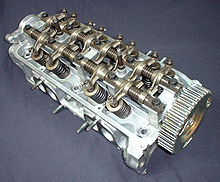
Anoverhead camshaft(OHC)engineis apiston enginein which thecamshaftis located in thecylinder headabove thecombustion chamber.[1][2]This contrasts with earlieroverhead valve engines(OHV), where the camshaft is located below the combustion chamber in theengine block.[3]
Single overhead camshaft(SOHC) engines have one camshaft perbank of cylinders.Dual overhead camshaft(DOHC, also known as "twin-cam"[4]) engines have two camshafts per bank. The first production car to use a DOHC engine was built in 1910. Use of DOHC engines slowly increased from the 1940s, leading to many automobiles by the early 2000s using DOHC engines.
Design
[edit]In an OHC engine, the camshaft is located at the top of the engine, above thecombustion chamber.This contrasts the earlieroverhead valve engine(OHV) andflathead engineconfigurations, where the camshaft is located down in theengine block.The valves in both OHC and OHV engines are located above the combustion chamber; however an OHV engine requirespushrodsandrocker armsto transfer the motion from the camshaft up to the valves, whereas an OHC engine has the valves directly actuated by the camshaft.
Compared with OHV engines with the same number of valves, there are fewer reciprocating components and less valvetrain inertia in an OHC engine. This reduced inertia in OHC engines results in lessvalve floatat higher engine speeds (RPM).[1]A downside is that the system used to drive the camshaft (usually a timing chain in modern engines) is more complex in an OHC engine, such as the 4-chain valvetrain of the Audi 3.2 or the 2 meter chain on Ford cammers. Another disadvantage of OHC engines is that during engine repairs where the removal of thecylinder headis required, the camshaftengine timingneeds to be reset. In addition, an OHC engine has a large cylinder head to accommodate the camshaft or an extra set of valves to increase theVolumetric efficiency,so that with the same displacement as an OHV engine, the OHC engine will end up being the physically larger of the two mostly due to the enlarged cylinder head.
The other main advantage of OHC engines is that there is greater flexibility to optimise the size, location and shape of the intake and exhaust ports, since there are no pushrods that need to be avoided.[1]This improves the gas flow through the engine, increasing power output andfuel efficiency.
Single overhead camshaft (SOHC)
[edit]
The oldest configuration of overhead camshaft engine is thesingle overhead camshaft(SOHC) design.[1]A SOHC engine has one camshaft per bank of cylinders, therefore astraight enginehas a total of one camshaft and aV engineorflat enginehas a total of two camshafts (one for each cylinder bank).
Most SOHC engines have two valves per cylinder, one intake valve and one exhaust valve.[a]Motion of the camshaft is usually transferred to the valves either directly (using a tappet) or indirectly via arocker arm.[1]
Dual overhead camshaft (DOHC)
[edit]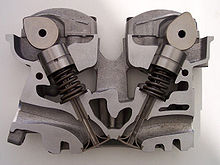
Adual overhead cam,double overhead cam,ortwin-camengine has two camshafts over each bank of the cylinder head,[1][2]one for the intake valves and another for the exhaust valves. Therefore there are two camshafts for a straight engine and a total of four camshafts for a V engine or a flat engine.
AV engineorflat enginerequires four camshafts to function as a DOHC engine, since having two camshafts in total would result in only a single camshaft per cylinder bank for these engine layouts. Some V engines with four camshafts have been marketed as "quad-cam" engines,[9]however technically "quad-cam" would require four camshafts per cylinder bank (i.e. eight camshafts in total), therefore these engines are merelydual overhead camshaftengines.
Many DOHC engines have four valves per cylinder.[b]The camshaft usually operates the valves directly via a buckettappet.A DOHC design permits a wider angle between intake and exhaust valves than in SOHC engines, which improves the air-fuel mixture's flow through the engine. A further benefit is that the spark plug can be placed at the optimum location, which in turn improves combustion efficiency. Another newer benefit of DOHC engine design is the ability to independently change/phase the timing between each camshaft and the crankshaft. This affords better fuel economy by allowing a broader torque curve. Although each major manufacturer has their own trade name for their specific system of variable cam phasing systems, overall they are all classified asvariable valve timing.
Components
[edit]Timing belt / timing chain
[edit]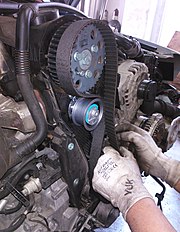
The rotation of a camshaft is driven by acrankshaft.Many 21st century engines use a toothedtiming beltmade from rubber and kevlar to drive the camshaft.[1][10]Timing belts are inexpensive, produce minimal noise and have no need for lubrication.[11]: 93 A disadvantage of timing belts is the need for regular replacement of the belt;[11]: 94 recommended belt life typically varies between approximately 50,000–100,000 km (31,000–62,000 mi).[11]: 94–95 [12]: 250 If the timing belt is not replaced in time and fails and the engine is aninterference engine,major engine damage is possible.
The first known automotive application of timing belts to drive overhead camshafts was the 1953Devin-Panhardracing specials built for the SCCA H-modified racing series in the United States.[13]: 62 These engines were based on Panhard OHV flat-twin engines, which were converted to SOHC engines using components from Norton motorcycle engines.[13]: 62 The first production car to use a timing belt was the 1962Glas 1004compact coupe.[14]
Another camshaft drive method commonly used on modern engines is atiming chain,constructed from one or two rows of metalroller chains.[1][10]By the early 1960s most production automobile overhead camshaft designs used chains to drive the camshaft(s).[15]: 17 Timing chains do not usually require replacement at regular intervals, however the disadvantage is that they are noisier than timing belts.[12]: 253
Gear train
[edit]Agear trainsystem between the crankshaft and the camshaft is commonly used in diesel overhead camshaft engines used in heavy trucks.[16]Gear trains are not commonly used in engines for light trucks or automobiles.[1]
Other camshaft drive systems
[edit]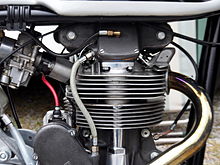
Several OHC engines up until the 1950s used a shaft withbevel gearsto drive the camshaft. Examples include the 1908–1911Maudslay 25/30,[17][18]theBentley 3 Litre,[19]the 1917-?Liberty L-12,[20]the 1929-1932MG Midget,the 1925-1948Velocette K series,[21]the 1931-1957Norton Internationaland the 1947-1962Norton Manx.[22]In more recent times, the 1950-1974Ducati Single,[23]1973-1980Ducati L-twin engine,1999-2007Kawasaki W650and 2011-2016Kawasaki W800motorcycle engines have used bevel shafts.[24][25]TheCrosleyfour cylinder was the last automotive engine to use the shaft tower design to drive the camshaft, from 1946 to 1952; the rights to the Crosley engine format were bought by a few different companies, includingGeneral Tirein 1952, followed byFageolin 1955, Crofton in 1959,Homelitein 1961, andFisher Piercein 1966, after Crosley closed the automotive factory doors, and they continued to produce the same engine for several more years.
A camshaft drive using three sets of cranks and rods in parallel was used in the 1920–1923Leyland Eightluxury car built in the United Kingdom.[26][27][28]A similar system was used in the 1926-1930Bentley Speed Sixand the 1930-1932Bentley 8 Litre.[28][29]A two-rod system with counterweights at both ends was used by many models of the 1958-1973NSU Prinz.[15]: 16-18
History
[edit]1900–1914
[edit]Among the first overhead camshaft engines were the 1902MaudslaySOHC engine built in the United Kingdom[18]: 210 [15]: 906 [30]and the 1903Marr Auto CarSOHC engine built in the United States.[31][32]The first DOHC engine was a Peugeot inline-four racing engine which powered the car that won the1912 French Grand Prix.Another Peugeot with a DOHC engine won the1913 French Grand Prix,followed by theMercedes-Benz 18/100 GPwith an SOHC engine winning the1914 French Grand Prix.
TheIsotta Fraschini Tipo KM— built in Italy from 1910–1914— was one of the first production cars to use an SOHC engine.[33]
World War I
[edit]
During World War I, both theAlliedandCentral Powers;specifically those of theGerman Empire'sLuftstreitkräfteair forces, sought to quickly apply the overhead camshaft technology of motor racing engines to military aircraft engines. The SOHC engine from theMercedes 18/100 GPcar (which won the 1914 French Grand Prix) became the starting point for both Mercedes' and Rolls-Royce's aircraft engines. Mercedes created a series of six-cylinder engines which culminated in theMercedes D.III.Rolls-Royce reversed-engineered the Mercedes cylinder head design based on a racing car left in England at the beginning of the war, leading to theRolls-Royce EagleV12 engine. Other SOHC designs included the SpanishHispano-Suiza 8V8 engine (with a fully enclosed-drivetrain), the AmericanLiberty L-12V12 engine, which closely followed the later Mercedes D.IIIa design's partly-exposed SOHC valvetrain design; and theMax Friz-designed; GermanBMW IIIastraight-six engine. The DOHCNapier LionW12 engine was built in Great Britain beginning in 1918.
Most of these engines used a shaft to transfer drive from the crankshaft up to the camshaft at the top of the engine. Large aircraft engines— particularly air-cooled engines— experienced considerable thermal expansion, causing the height of the cylinder block to vary during operating conditions. This expansion caused difficulties for pushrod engines, so an overhead camshaft engine using a shaft drive with sliding spline was the easiest way to allow for this expansion. These bevel shafts were usually in an external tube outside the block, and were known as "tower shafts".[34]
-
1914–1918Hispano-Suiza 8ASOHC aircraft engine
-
1914–1918Hispano-Suiza 8BeSOHC aircraft engine with "tower shafts" at the rear of each cylinder bank
-
Later production (1917-18)Mercedes D.IIIupper valvetrain details sketch, its design features copied by theBMW IIIand the AlliedLiberty L-12engines
-
Detail closeup of aLiberty L-12's upper valvetrain, showing the similarity to the later-production Mercedes design
1919–1944
[edit]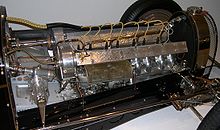
An early American overhead camshaft production engine was the SOHC straight-eight engine used in the 1921–1926Duesenberg Model Aluxury car.[35]
In 1926, theSunbeam 3 litre Super Sportsbecame the first production car to use a DOHC engine.[36][37]
In the United States, Duesenberg added DOHC engines (alongside their existing SOHC engines) with the 1928 release of theDuesenberg Model J,which was powered by a DOHC straight-eight engine. The 1931–1935Stutz DV32was another early American luxury car to use a DOHC engine. Also in the United States, the DOHCOffenhauserracing engine was introduced in 1933. This inline-four engine dominated North American open-wheel racing from 1934 until the 1970s.
Other early SOHC automotive engines were the 1920–1923Wolseley Ten,the 1928-1931MG 18/80,the 1926–1935Singer Juniorand the 1928–1929Alfa Romeo 6C Sport.Early overhead camshaft motorcycles included the 1925–1949Velocette K Seriesand the 1927–1939Norton CS1.
1945–present
[edit]
The 1946–1948Crosley CC Fourwas arguably the first American mass-produced car to use an SOHC engine.[38][39][40]This small mass-production engine powered the winner of the 195012 Hours of Sebring.[38]: 121
Use of a DOHC configuration gradually increased after World War II, beginning with sports cars. Iconic DOHC engines of this period include the 1948–1959Lagonda straight-six engine,the 1949–1992Jaguar XKstraight-six engine and the 1954–1994Alfa Romeo Twin Caminline-four engine.[41][42]The 1966-2000Fiat Twin Caminline-four engine was one of the first DOHC engines to use a toothed timing belt instead of a timing chain.[43]
In the 1980s, the need for increased performance while reducing fuel consumption and exhaust emissions saw increasing use of DOHC engines in mainstream vehicles, beginning with Japanese manufacturers.[41]By the mid-2000s, most automotive engines used a DOHC layout.[citation needed]
See also
[edit]Footnotes
[edit]- ^However a few engines, such as the 1973Triumph Dolomite Sprint engineandHonda J Series V6 Enginewere/are a SOHC configuration with four valves per cylinder. This was achieved by the camshaft being located in the center of the cylinder head, with equal length rocker arms actuating the intake and exhaust valves.[5]This arrangement was used to provide four valves per cylinder while minimising the valvetrain mass and minimising the overall engine size.[6][7][8]
- ^However DOHC engines with two valves per cylinder include theAlfa Romeo Twin Cam engine,theJaguar XK6 engine,the earlyFord I4 DOHC engine,10VVolvo Modular engineand theLotus Ford Twin Cam engine.
References
[edit]- ^abcdefghiHillier, V.A.W. (2012) [First published 1966]. "2".Fundamentals of Motor Vehicle Technology(Academic text-book). Vol. Book 1. In association with: (IMI) (6th ed.). Nelson Thornes Ltd.ISBN9781408515181.
- ^abStoakes, Graham; Sykes, Eric; Whittaker, Catherine (2011). "3".Principles of Light Vehicle maintenance & repair.Heinmann Work-Based Learning. Babcock International Group and Graham Stoakes. pp. 208–209.ISBN9780435048167.
- ^"OHV, OHC, SOHC and DOHC (twin cam) engine - Automotive illustrated glossary".www.samarins.com.Retrieved2018-09-20.
- ^Harley-Davidson Twin Cam engine,Fiat Twin Cam engine,Alfa Romeo Twin Cam engine,Quad 4 engine,Lotus-Ford Twin Cam
- ^Heseltine, Richard (June 2010). Roebuck, Nigel (ed.)."Triumph Dolomite Sprint".Motor Sport.86(6). London, UK: 122.ISSN0027-2019.Retrieved29 March2015.
- ^Lewis, Jimmy (November 2001). Edwards, David (ed.)."New for '02: Honda CR250R CRF450R".Cycle World.40(11). Hachette-Filipacchi Magazines: 62.ISSN0011-4286.Retrieved2 January2015.
- ^"How It Works: Honda Unicam® Engines".www.honda.com.23 January 2013. Archived fromthe originalon 22 February 2014.Retrieved2 January2015.
- ^"2010 Honda VFR1200A First Ride".www.moto123.com.19 October 2009.Archivedfrom the original on 2 January 2015.Retrieved2 January2015.
- ^"Technically Interesting: Ford Indy DOHC V8".Bring a Trailer.26 April 2018.Retrieved6 September2022.
- ^ab"Dan's motorcycle 'Cam Drives'".www.dansmc.com.Retrieved29 August2012.
- ^abcDecker, John (June 1993). Oldham, Joe (ed.)."Saturday Mechanic: Replacing Your Timing Belt".Popular Mechanics.170(6). New York, NY US: Hearst.ISSN0032-4558.Retrieved1 March2015.
- ^abDorries, Elisabeth H. (2005).TechOne: Automotive Engine Repair.Clifton Park, NY US: Thompson Delmar Learning.ISBN1-4018-5941-0.LCCN2004057974.Retrieved1 March2015.
- ^abPace, Harold W.; Brinker, Mark R. (2004).Vintage American Road Racing Cars 1950-1969.St. Paul MN US: MotorBooks International. p. 62.ISBN0-7603-1783-6.Retrieved27 February2015.
- ^Norbye, Jan P. (1984)."Expanding on Excellence: The 5-Series and 3-Series".BMW - Bavaria's Driving Machines.Skokie, IL: Publications International. p.191.ISBN0-517-42464-9.
- ^abcBoddy, William(January 1964)."Random Thoughts About O.H.C."Motor Sport.XL(1). London, UK: Teesdale Publishing.
- ^Bennett, Sean (2014-01-01).Modern Diesel Technology: Diesel Engines.Stamford, CT US: Cengage Learning. pp. 88–89, 362.ISBN978-1-285-44296-9.Retrieved4 January2015.
In most commercial diesels, OHCs are gear-driven.
- ^Boddy, William(August 1972). Boddy, William (ed.)."An Edwardian Overhead-Camshaft 25/30 Maudslay".Motor Sport.XLVIII(8). London, UK: Teesdale Publishing: 909.Archivedfrom the original on 6 February 2015.Retrieved6 February2015.
- ^abCulshaw, David; Horrobin, Peter (2013) [1974]. "Maudslay".The Complete Catalogue of British Cars 1895 - 1975(e-book ed.). Poundbury, Dorchester, UK: Veloce Publishing. p. 210.ISBN978-1-845845-83-4.
- ^Norbye, Jan P. (1981).The complete handbook of automotive power trains.Tab Books. p. 318.ISBN0-8306-2069-9.LCCN79026958.Retrieved7 January2015.
- ^Department, United States Bureau of Aircraft Production Airplane Engineering (March 4, 1918)."The Bulletin of the Airplane Engineering Department, U.S.A."War Department, Bureau of Aircraft Production, Airplane Engineering Department – via Google Books.
- ^Cameron, Kevin(March 2004)."TDC: Little things".Cycle World.43(3): 14.ISSN0011-4286.Retrieved7 January2015.
- ^Wilson, Hugo (1995). "The A-Z of Motorcycles".The Encyclopedia of the Motorcycle.London, UK: Dorling Kindersley. p.144.ISBN0-7513-0206-6.
- ^Walker, Mick(2003) [1991]."4 Engine".Ducati Singles Restoration.St. Paul, MN US: Motorbooks International. p. 48.ISBN0-7603-1734-8.Retrieved4 January2015.
- ^"2015 W800".www.kawasaki.eu.Retrieved19 December2019.
- ^Ash, Kevin(26 October 2011)."Kawasaki W800 review".The Telegraph.Archivedfrom the original on 21 June 2013.
- ^A US patent 1495620 A,John Godfrey Parry Thomas, "Internal Combustion Engine", issued 1924-05-27
- ^U.S. patent 1,495,620
- ^abBoddy, William(March 1974). Boddy, William (ed.)."How Did The Leyland Eight Rate?".Motor Sport.L(3): 230.Retrieved3 January2015.
- ^Brooks, Philip C. (2009). Carpenter, Rhonda; Iwalani, Kahikina (eds.). "The Mighty Sixes".The International Club for Rolls-Royce & Bentley Owners Desk Diary 2010.Tampa, FL USA: Faircount: 27, 32.
- ^Georgano, G. N.(1982) [1968]."Maudslay".In Georgano, G. N. (ed.).The New Encyclopedia of Motorcars 1885 to the Present(Third ed.). New York: E. P. Dutton. p.407.ISBN0525932542.LCCN81-71857.
- ^"Marr Auto Car Company".www.marrautocar.com.Archived fromthe originalon 11 April 2018.
- ^Kimes, Beverly Rae (2007).Walter L Marr: Buick's Amazing Engineer.Racemaker Press. p. 40.ISBN978-0976668343.
- ^"1913 Isotta Fraschini 100-120 hp Tipo KM 4 Four-Seat Torpedo Tourer - Auction Lot".www.motorbase.com.Retrieved29 December2019.
- ^Thorpe, Leslie Aaron (1936).A text book on aviation: the new cadet system of ground school training.Vol. 3. Aviation Press. pp. 14–15.Retrieved27 February2015.
The overhead camshafts are driven by bevel gears and vertical shafts known as tower shafts.
- ^Mueller, Mike (2006)."Chapter 6 - Chariot of the Gods Duesenberg Straight Eight".American Horsepower 100 Years of Great Car Engines.St. Paul, MN USA: Motorbooks. p. 51.ISBN978-0-7603-2327-4.LCCN2006017040.Retrieved2015-02-02.
- ^"Talking of sports cars: Sunbeam three-litre".Autocar.147 (nbr 4221): 69–71. 1 October 1977.
- ^Georgano, G.N. (1985).Cars: Early and Vintage, 1886-1930.London: Grange-Universal.
- ^abSimanaitis, Dennis (January 1994). Bryant, Thos L. (ed.). "Tech Tidbits".Road & Track.45(6). Newport Beach, CA US: Hachette Filipacchi Magazines: 121.ISSN0035-7189.
- ^"Crosley Engine Family Tree - Taylor Years".www.crosleyautoclub.com.Retrieved19 December2019.
- ^"Crosley Engine Family Tree - CoBra Years".www.crosleyautoclub.com.Retrieved19 December2019.
- ^ab"An Echo of the Past — the history and evolution of twin-cam engines".www.EuropeanCarWeb.com.European Car Magazine, Source Interlink Media. February 2009. Archived fromthe originalon 3 March 2012.Retrieved29 August2012.
- ^"Technical- Boxer History".www.alfisti.co.uk.Archivedfrom the original on 29 March 2013.
- ^"Old Fiat ad with Aurelio Lampredi".www.kinja-img.com.Retrieved31 January2015.




